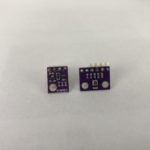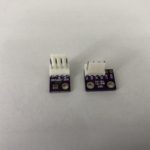Many makers are using breakout boards for their projects, they are easy to use, as additional required components are already included on them, like pullup resistors and capacitors.
But, sometimes there are also components soldered on those breakouts which are not required for a project.
I’m aware of two different BME280 breakouts from China, a 6-pin one and a 4-pin one.
The 6-pin breakout only consist of a few parts, the BME280 sensor, some capacitors and resistors.
The 4-pin breakout consists of a few parts more, the BME280 sensor, some capacitors and resistors, a voltage regulator and a to me unknown chip.
Low power projects are often run from battery, there the amount of power over time is limited. Here the standby/sleep current is the most important one, as the sensor is most of the time doing nothing.
The sensor was put into ‘forced mode’ for all measurements in this post and was powered from a 3.3V source. For the measurements a Siglent SDS 1102CML+ was used combined with an uCurrent GOLD.
Stock 4-pin breakout: 7.66uA
Stock 6-pin breakout: 0.173uA
So you can clearly see, that the 6-pin breakout is better suited for low power applications as it uses 44 times less power, but you have to take care to supply the correct voltage, according to the datasheet:
‘Supply voltage VDD main supply voltage range: 1.71 V to 3.6 V’
But what happens if we do remove the voltage regulator on the 4-pin breakout?
4-pin breakout without regulator: 0.179uA
If the regulator is removed, the result is nearly the same as with the 6-pin breakout.
So you can either use the 6-Pin version or the 4-Pin version and remove the regulator and solder in a piece of wire.



